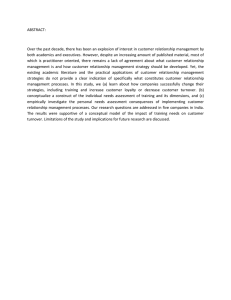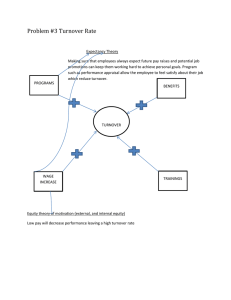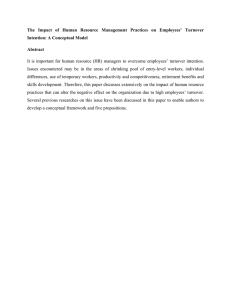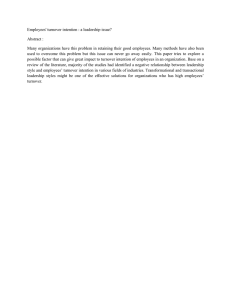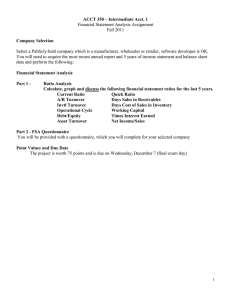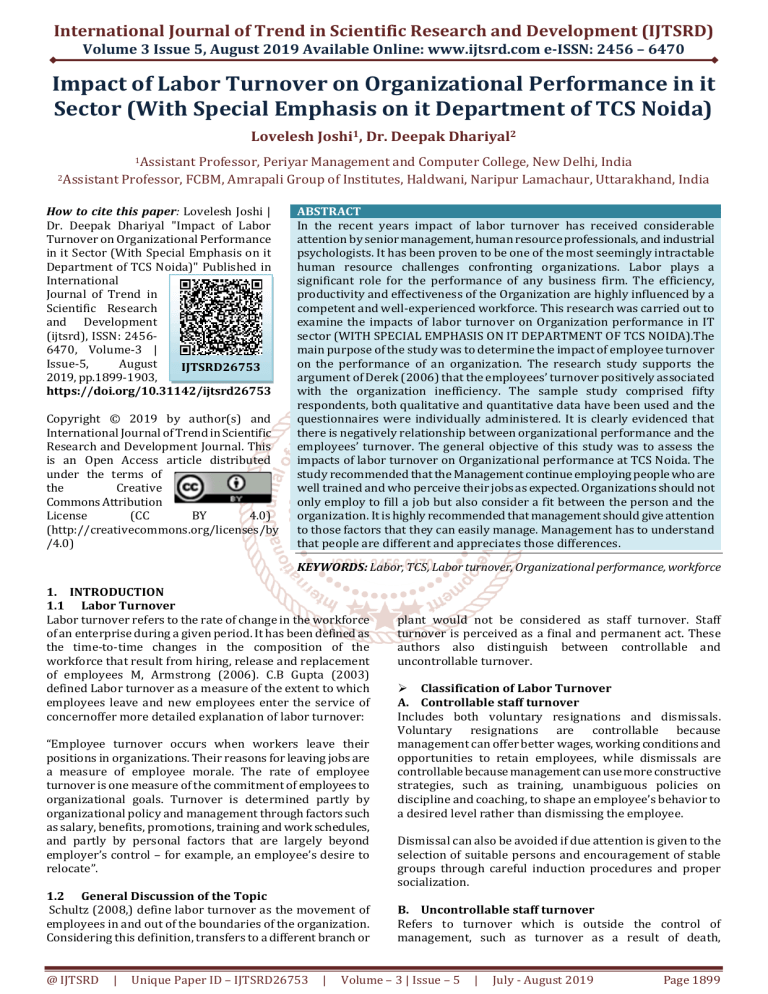
International Journal of Trend in Scientific Research and Development (IJTSRD)
Volume 3 Issue 5, August 2019 Available Online: www.ijtsrd.com e-ISSN: 2456 – 6470
Impact of Labor Turnover on Organizational Performance in it
Sector (With Special Emphasis on it Department of TCS Noida)
Lovelesh Joshi1, Dr. Deepak Dhariyal2
1Assistant
2Assistant
Professor, Periyar Management and Computer College, New Delhi, India
Professor, FCBM, Amrapali Group of Institutes, Haldwani, Naripur Lamachaur, Uttarakhand, India
How to cite this paper: Lovelesh Joshi |
Dr. Deepak Dhariyal "Impact of Labor
Turnover on Organizational Performance
in it Sector (With Special Emphasis on it
Department of TCS Noida)" Published in
International
Journal of Trend in
Scientific Research
and Development
(ijtsrd), ISSN: 24566470, Volume-3 |
Issue-5,
August
IJTSRD26753
2019, pp.1899-1903,
https://doi.org/10.31142/ijtsrd26753
Copyright © 2019 by author(s) and
International Journal of Trend in Scientific
Research and Development Journal. This
is an Open Access article distributed
under the terms of
the
Creative
Commons Attribution
License
(CC
BY
4.0)
(http://creativecommons.org/licenses/by
/4.0)
ABSTRACT
In the recent years impact of labor turnover has received considerable
attention by senior management, human resource professionals, and industrial
psychologists. It has been proven to be one of the most seemingly intractable
human resource challenges confronting organizations. Labor plays a
significant role for the performance of any business firm. The efficiency,
productivity and effectiveness of the Organization are highly influenced by a
competent and well-experienced workforce. This research was carried out to
examine the impacts of labor turnover on Organization performance in IT
sector (WITH SPECIAL EMPHASIS ON IT DEPARTMENT OF TCS NOIDA).The
main purpose of the study was to determine the impact of employee turnover
on the performance of an organization. The research study supports the
argument of Derek (2006) that the employees’ turnover positively associated
with the organization inefficiency. The sample study comprised fifty
respondents, both qualitative and quantitative data have been used and the
questionnaires were individually administered. It is clearly evidenced that
there is negatively relationship between organizational performance and the
employees’ turnover. The general objective of this study was to assess the
impacts of labor turnover on Organizational performance at TCS Noida. The
study recommended that the Management continue employing people who are
well trained and who perceive their jobs as expected. Organizations should not
only employ to fill a job but also consider a fit between the person and the
organization. It is highly recommended that management should give attention
to those factors that they can easily manage. Management has to understand
that people are different and appreciates those differences.
KEYWORDS: Labor, TCS, Labor turnover, Organizational performance, workforce
1. INTRODUCTION
1.1 Labor Turnover
Labor turnover refers to the rate of change in the workforce
of an enterprise during a given period. It has been defined as
the time-to-time changes in the composition of the
workforce that result from hiring, release and replacement
of employees M, Armstrong (2006). C.B Gupta (2003)
defined Labor turnover as a measure of the extent to which
employees leave and new employees enter the service of
concernoffer more detailed explanation of labor turnover:
“Employee turnover occurs when workers leave their
positions in organizations. Their reasons for leaving jobs are
a measure of employee morale. The rate of employee
turnover is one measure of the commitment of employees to
organizational goals. Turnover is determined partly by
organizational policy and management through factors such
as salary, benefits, promotions, training and work schedules,
and partly by personal factors that are largely beyond
employer’s control – for example, an employee’s desire to
relocate”.
1.2 General Discussion of the Topic
Schultz (2008,) define labor turnover as the movement of
employees in and out of the boundaries of the organization.
Considering this definition, transfers to a different branch or
@ IJTSRD
|
Unique Paper ID – IJTSRD26753
|
plant would not be considered as staff turnover. Staff
turnover is perceived as a final and permanent act. These
authors also distinguish between controllable and
uncontrollable turnover.
Classification of Labor Turnover
A. Controllable staff turnover
Includes both voluntary resignations and dismissals.
Voluntary resignations are controllable because
management can offer better wages, working conditions and
opportunities to retain employees, while dismissals are
controllable because management can use more constructive
strategies, such as training, unambiguous policies on
discipline and coaching, to shape an employee’s behavior to
a desired level rather than dismissing the employee.
Dismissal can also be avoided if due attention is given to the
selection of suitable persons and encouragement of stable
groups through careful induction procedures and proper
socialization.
B. Uncontrollable staff turnover
Refers to turnover which is outside the control of
management, such as turnover as a result of death,
Volume – 3 | Issue – 5
|
July - August 2019
Page 1899
International Journal of Trend in Scientific Research and Development (IJTSRD) @ www.ijtsrd.com eISSN: 2456-6470
retrenchments and incapacity. Avoidable turnover is
considered as controllable in the sense that management
could have minimized or prevented such loss.
The Measurements of Labor Turnover
1. The staff turnover rate (LTR)
The most commonly used measure for staff turnover is the
staff turnover rate (LTR). The LTR gives an indication of the
percentage of employees that leave the organization over a
period of time. The LTR is calculated by the means of the
following formula:
Number of leavers during a period (V + D)
----------------------------------------------------------- x 100
Average of number in employment during period
It should be noted that the monthly LTR may fluctuate
considerably and therefore the calculation of quarterly or
yearly rates are recommended as being more reliable. For
comparative purpose, rates should always be expressed on a
per annum basis, irrespective of the period over which they
are calculated. In other words, if a monthly LTR is calculated,
it should be multiplied by 12 (months), if a quarterly LTR is
calculated, it should be multiplied by four (terms).
1.3 Objectives of Study:
1. To investigate the cause of labour turnover in IT sector
with special focus on IT department in TCS Noida.
2. To determine the impact of labour turnover on
organization effectiveness.
3. To determine what impact labour turnover has on
employee performance in IT department.
4. To recommend strategies that can be used to reduce the
high level of labour turnover.
1.4 Scope of Study:
The aim of this research is to describe the impact of labor
turnover on organizational performance. Generally the study
focuses on the theoretical aspect of labor turnover covering
content, classification and methods of measuring it. The
special emphases were given on the strategies that can be
addressed to retain employees in IT sector at TCS Noida, IT
department.
2. LITERATURE REVIEW
2.1 Title
Employee turnover: “Employee turnover” as a term is widely
used in business circles By: Henry Ongori, Department of
Management, and University of Botswana, Botswana.
Although several studies have been conducted on this topic,
most of the researchers focus on the causes of employee
turnover but little has been done on the examining the
sources of employee turnover, effects and advising various
strategies which can be used by managers in various
organizations to ensure that there is employee continuity in
their
organizations
to
enhance
organizational
competitiveness. This paper examines the sources of
employee turnover, effects and forwards some strategies on
how to minimize employee turnover in organizations.
Organizations invest a lot on their employees in terms of
induction and training, developing, maintaining and
retaining them in their organization. Therefore, managers at
all costs must minimize employee’s turnover.
@ IJTSRD
|
Unique Paper ID – IJTSRD26753
|
Sources of employee turnover
1. Job related factors
There are several reasons why people quit from one
organisation to another or why people leave organization.
The experience of job related stress (job stress), the range
factors that lead to job related stress (stressor), lack of
commitment in the organization, and job dissatisfaction
make employees to quit.This clearly indicates that these are
individual decisions which make one to quit. They are other
factors like personal agency refers to concepts such as a
sense of powerlessness, locus of control and personal
control. Locus control refers to the extent to which people
believe that the external factors such as chance and powerful
others are in control of the events which influence their lives.
2. Voluntarily vs. involuntary turnover
There are some factors that are, in part, beyond the control
of management, such as the death or incapacity of a member
of staff. Other factors have been classed as involuntary
turnover in the past such as the need to provide care for
children or aged relatives. Today such factors should not be
seen as involuntary turnover as both government regulation
and company policies create the chance for such staff to
come back to work, or to continue to work on a more flexible
basis.
3. Organizational factor
Organizational instability has been shown to have a high
degree of high turnover. Indications are that employees are
more likely to stay when there is a predictable work
environment and vice versa (Zuber, 2001). In organizations
where there was a high level of inefficiency there was also a
high level of staff turnover (Alexander et al., 1994).
Therefore, in situations where organizations are not stable
employees tend to quit and look for stable organizations
because with stable organizations they would be able to
predict their career advancement.
2.2 Title
Employee turnover: cause of factor influencing turnover
BY: Beri G.C., Human Resource Tata McGraw New Delhi
In his study on the cause of factor influencing turnover and
retention of staff and retention problems for professional
have talked about the Working hours, workload and work
schedules which are also common concerns to both groups.
In addition, career development, promotion and
appreciation of contribution were important retention
factors, while a supportive professional environment,
reduction in workload and working hours and more flexible
work patterns were important to consultants.
2.3 Title
Causes of the cost of employees turnover
BY: Cosenza, Robert M.
Cosenza, Robert M. in his study on the causes of the cost of
employees turnover due solely to unfairness in the
workplace and have talked about the effect of unfairness
upon an employee’s decision to leave their employer and the
financial to employer due to voluntary turnover. Further he
highlighted Recruiting and retaining the best and the
brightest remove the barriers and biases which create unfair
workplace.
Volume – 3 | Issue – 5
|
July - August 2019
Page 1900
International Journal of Trend in Scientific Research and Development (IJTSRD) @ www.ijtsrd.com eISSN: 2456-6470
3. RESEARCH METHODOLOGY
3.1 Introduction: This chapter describes the research
design that was used during data collection sampling
methods and techniques that were followed. This
chapter also describes the research instruments and
data analysis tools and methods as well as the tools
used in reporting.
3.2 Research Design: The study adopted a descriptive
research design since the study intendeds to gather
quantitative and qualitative data that describes the
nature and characteristics of the impacts of labour
turnover on organization performance.The study
considers this design appropriate since it facilitated
towards gathering of reliable data describing the true
characteristics of the impacts of labour turnover on
organization performance.
3.3
Sample Selection: The data has been collected from
total number f the employees in the IT department of
TCS Noida organization.
3.4
Sample Size: The Target population comprised of all
employees working at IT department of TCS Noida
.Because the target population was only 50 employees
so there was no need of select a sample size. All of
them have responded. Thus the sample size of this
research selection is 50.
3.5
3.6
Data Collection: Collection of data is done by primary
data through Questionnaire. The questionnaire
consisted of 18-item scale to measure employee
engagement using 5 point likert scale. Data was
collected using a structured close ended pre-coded
questionnaire.
Data Analysis: After data collection, analysis on
employer’s views, ideas and opinions was done which
would help the organization.
3.7
Sampling Technique: -Using Convenience sampling
technique 50 respondents were selected.
3.8
Data Interpretation: Interpretation of data is done
by using SPSS tools and also using descriptive statistic
tools (by using these techniques) accurate
information is obtained.
3.9
FORMULATION
OF
HYPOTHESES:
Several
hypotheses were formulated, using Statistical Package
for Social Sciences (SPSS) version 15 for Widows, to
test for significance in the empirical analysis. These
will be discussed further in chapter 4.
Ho1 There is a significant relationship between labour
turnover and organizational effectiveness.
Ho2 There is a significant relationship between labour
turnover and employee’s performance.
Ho3 There is a significant relationship between employee’s
performance and organizational effectiveness.
Ho4 There is a significant relationship between ways to
reduce labour turnover and organizational
effectiveness.
Ho5 There is a significant relationship between ways to
reduce labour turnover and employee’s performance.
@ IJTSRD
|
Unique Paper ID – IJTSRD26753
|
4. DATA ANALYSIS AND INTERPRETATION
4.1 Introduction
This chapter focuses on the interpretation of data collected
from the questionnaire which was distributed among the
participants and also the study on the specific issues that
were raised earlier in the objectives of the study.
4.2 HYPOTHESIS TESTING
According to Wilson (2010:237) hypothesis testing is one of
the main methods to test for significant relationship between
variables. It involves an analysis of some aspect of the
statement or questions that generates a statistical value. The
Person Chi square test was performed to test hypotheses
using the Statistical Package for Social Sciences (SPSS)
version 15 for Windows. The Chi square test was performed
to determine whether there was a statistically significant
relationship between the variables.
Hypotheses 1
There is a significant relationship between labor turnover
and organizational effectiveness.
LABOR
TURNOVER
EFFECTIVENESS (N=50)
AND
ORGANISATIONAL
Value
df
Asymp. Sig.
(2-sided)
Pearson ChiSquare
492.570a
306
.000
Likelihood Ratio
184.038
306
1.000
Linear-by-Linear
Association
7.951
1
.005
N of Valid Cases
98
Pearson’s Chi-square =492.570, df= 306, significance
p<0.000.
Interpretation:It shows a highly positive relationship
between labor turnover and organizational effectiveness.
Pearson’s test showed a significant correlation (p<0.000).
There is significant economic impact when an organization
loses any of its valuable employees, especially given the
knowledge that is lost with the employee’s departure.
Hypotheses 2
There is a significant relationship between labor turnover
and employee’s performance.
LABOR TURNOVER AND EMPLOYEE PERFORMANCE
(N=50)
Asymp. Sig.
Value
df
(2- sided)
Pearson Chi
.000
Square
407.754a 306
Likelihood Ratio
195.769
Linear-by-Linear
Association
2.111
306
1.000
1
.146
N of Valid Cases
50
Pearson Chi-square =407.754, df= 306, significant p< 0.000.
Interpretation: The results reflected a positive relationship
between staff turnover and employee performance. The
Pearson’s test showed a significant correlation (p<0.000).
Volume – 3 | Issue – 5
|
July - August 2019
Page 1901
International Journal of Trend in Scientific Research and Development (IJTSRD) @ www.ijtsrd.com eISSN: 2456-6470
Hypotheses 3
There is a significant relationship between employee’s
performance and organizational effectiveness.
RELATIONSHIPBETWEEN EMPLOYEE PERFORMANCE
AND ORGANISATIONAL EFFECTIVENESS (N=50)
Asymp. Sig.
Value
df
(2- sided)
a
.000
Pearson Chi-Square 410.900
289
Likelihood Ratio
185.527 289
1.000
Linear-by-Linear
1
.001
11.551
Association
N of Valid Cases
50
Pearson Chi-square =410.900, df= 289, significant p< 0.000.
Interpretation: It reveals that the results reflect a highly
positive relationship between employeeperformance and
organizational effectiveness. A Pearson’s test showed a
positive correlation (p<0.000).Effectiveness could be defined
as the degree to which the organization realizes its goals.
Hypotheses 4
There is a significant relationship between ways to reduce
labor turnover and organizational effectiveness.
WAYS TO REDUCE LABOR TURNOVER AND
ORGANIZATIONAL EFFECTIVENESS(N=50)
Asymp. Sig.
Value
df
(2- sided)
a
Pearson Chi-Square 218.920
170
.007
Likelihood Ratio
146.286 170
.906
Linear-by-Linear
8.374
1
.004
Association
N of Valid Cases
50
Pearson Chi-square =218.920, df= 170, significant p< 0.007.
Interpretation: There is a significant association between
ways to reduce staff turnover and organisational
effectiveness. The Pearson’s test showed a significant
correlation (p<0.007).
Hypotheses 5
There is a significant relationship between ways to reduce
labor turnover and employee’s performance.
WAYS TO REDUCE LABOR TURNOVER AND EMPLOYEE
PERFORMANCE (N=50)
Asymp.Sig.
Value
df
(2- sided)
a
Pearson Chi-Square 206.229 170
.030
Likelihood Ratio
158.894 170
.719
Linear-by-Linear
16.669
1
.000
Association
N of Valid Cases
98
Person Chi-square =206.229, df= 170, significant p< 0.030.
Interpretation: The results reflect a significant relationship
between employee performance and ways to reduce staff
turnover. The Pearson’s test showed a significant correlation
(p<0.030).
@ IJTSRD
|
Unique Paper ID – IJTSRD26753
|
5. FINDINGS& CONCLUSION
A total of 100% of respondents agreed that high
turnover increases work load for each employee.
78% of the respondents agreed that they were not
satisfied with working conditions.
86% of the respondents agreed that work boredom is
the cause of staff turnover .
It is noted that labor turnover has a negative impact on
the organisational productivity and on employee
performance.
Labor turnover may be caused by lack of opportunities
for career development, remuneration and working
condition.
Labor turnover if not taken into consideration will
damage the image of the organisation, where customers
will lose trust in the organisation.
Moreover, productivity of the organisation will also
decrease, while employees will be demotivated to work
for a company with high labor turnover rate.
Organizations will need to either create an intellectual
capital environment where the transmission of
knowledge takes place throughout the structure.
6. CONCLUSION
This study focused on the impact of labor turnover on
organizational effectiveness and employee performance in
the IT sector with reference to IT department TCS noida.
Labor turnover may be caused by lack of opportunities for
career development, remuneration and working condition.
This study therefore makes recommendations arising from
the empirical analysis, to reduce Labor turnover in the IT
department TCS noida.Poor working condition was also a
factor which was cited as the reason for labor turnover, the
relationship with immediate supervisors has also been
mentioned by most respondents as a factor for employee
turnover.Involvement in decision-making and lack of
autonomy were all cited as the challenge that triggers
employees turnover. Therefore it is suggested that
employees’ recognition and motivation towards
organizational performance have a positive relationship in
between them. Of further importance, the Management is
advised to provide employees with autonomy in such a way
that they feel ownership of their organization.
7. Recommendation
Management should give attention to those factors that
they can control, including communication with staff,
fair treatment, recognition for effort and performance,
participation in decision making, providing support and
encouragement, and training and developing staff to
prepare them for promotion and enhanced
responsibility.
Top management should develop employee assistance
programmes in the organisation to assist employees
with problems to eliminate absenteeism or labor
turnover.
Top management should reduce work boredom to
employees by revisiting employee’s job description in
order to add some challenge job tasks on the employee’s
job description.
Top management should give due recognition to its
internal employees when there are new positions within
the organisation. Clear, achievable goals and standards
for each position should be set and should be known to
employees.
Volume – 3 | Issue – 5
|
July - August 2019
Page 1902
International Journal of Trend in Scientific Research and Development (IJTSRD) @ www.ijtsrd.com eISSN: 2456-6470
Top management should also appreciate employee’s
input in the organisation when they meet organisational
goals. Appreciation can be through announcement or
writing a letter of commendation and placing it in the
notice board or provide some incentives.
REFRENCES
[1] C.R Kothari- Research Methodology.
[2] http://shodhganga.inflibnet.ac.in/handle/10603/1740
76
[3] Shodhganga.inflibnet.ac.in/bitstream/10603/124704/
17/17_synopsis.pdf
[4]
Job Satisfaction in IT Sector, Journal of Business
Management & Social Sciences Research (JBM&SSR)
@ IJTSRD
|
Unique Paper ID – IJTSRD26753
|
ISSN No: 2319-5614 Volume 3, No.5, May 2014, Preeti
Thakur,
[5] Griffith, R.w, (2000). A Meta-Analysis of Antecedents
and Correlates of Employee Turnover: Update,
moderator test and research implications for the next
millennium. Journal of Management, 26(3), pp. 463488.
[6] Employee turnover: “Employee turnover” as a term is
widely used in business circles By: HenryOngori,
Department of Management, University of Botswana,
Botswana.
[7] Page, N. (2001). Costs of staff turnover. Online.
Available
at:
http://www.bestbooks.biz/htm/emoloyee_involvemen
t.htm Date accessed: 12 July 2009.
Volume – 3 | Issue – 5
|
July - August 2019
Page 1903

